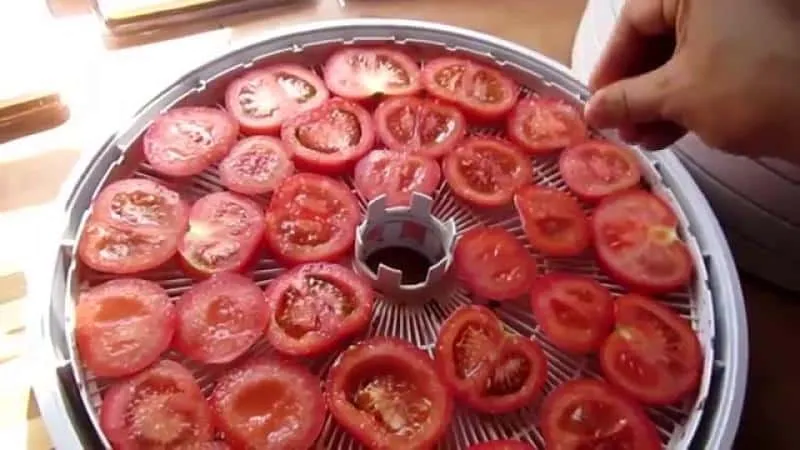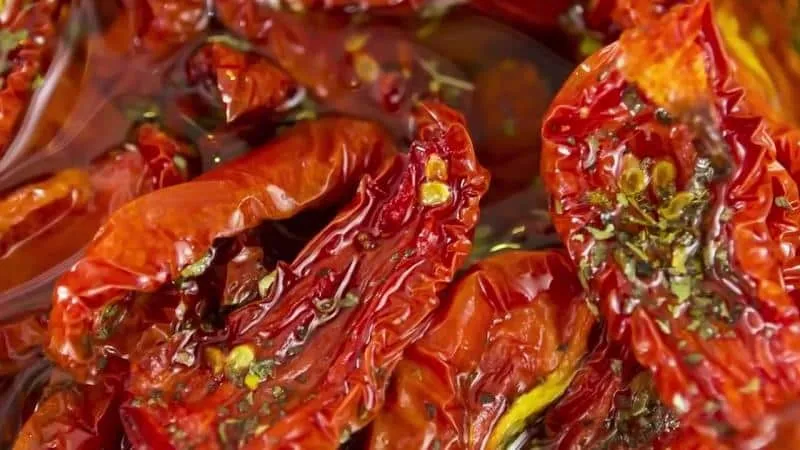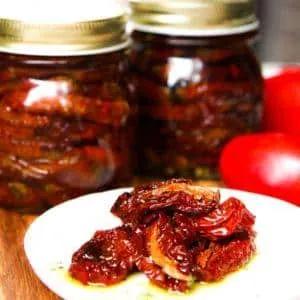What a variety of dishes can be prepared from tomatoes! This juicy and flavourful fruit allows both experienced and beginner cooks to unleash their creativity, as there’s nothing complicated about cooking with them. Despite the diversity of recipes, some of the most popular tomato-based dishes in Europe include sun-dried tomatoes, tomato confit, and tomato paste.
If you visit Italy, Spain, Greece, or other Mediterranean countries, it’s hard not to try sun-dried tomatoes, which are added to almost every dish. This savoury delicacy can also take pride of place on your table: in this article, you’ll find the best variations of recipes for making sun-dried tomatoes at home.
Table of contents
Are Sun-Dried Tomatoes Healthy?
The healthiest product is a fresh one, so nothing can replace a tomato just picked from the garden. However, this doesn’t mean you should avoid other variations and culinary experiments with this vegetable, as the drying process (unlike boiling or stewing) preserves most of the beneficial properties. This means that sun-dried tomatoes are rich in dietary fibre, di- and monosaccharides, and consequently, they improve digestion.
Note. The calorie content of sun-dried tomatoes is relatively low — only 258 kcal per 100 grams, with a macronutrient ratio (BJU) of 14.1 g protein, 3.0 g fat, and 43.5 g carbohydrates. Therefore, they can safely be included in the diet of those who watch their nutrition and fitness.
Sun-dried tomatoes contain a lot of potassium, and their regular consumption helps prevent vision problems and reduces the risk of blood clots. They also help remove excess fluid from the body, preventing swelling.
Sun-dried tomatoes have a positive effect on the nervous system and, according to some studies, act as natural antidepressants due to their serotonin content. Additionally, they improve male potency when consumed regularly.
The health benefits of this product are indeed extensive, but remember that true benefits come only with moderate consumption. So, we recommend avoiding overindulgence, even if these sun-dried tomatoes are incredibly tasty!

How to Choose the Right Tomatoes for Drying
When selecting tomatoes for drying, opt for medium-sized fruits that aren’t overly juicy and are definitely red, as yellow or pink tomatoes contain more moisture. Preference should be given to garden-grown tomatoes rather than greenhouse varieties.
Of course, given urban living conditions, this isn’t always possible. Therefore, the best time to prepare tomatoes for drying is summer, when garden-fresh produce is more readily available.
Tip. Keep in mind that drying reduces the weight by about 90%, which is a key factor when choosing tomato size. Also, pick ripe tomatoes without dents, spots, or signs of rot.
Preparing Tomatoes for Drying
For drying, you need clean tomatoes: wash them, remove stems, cut them into halves or slices, and try to remove the seeds. There’s no need to peel them, as the skin helps maintain their shape.
To prepare the tomatoes for drying, wash them, remove the stems, and slice them into rings or lengthwise into several pieces. Make the slices thin to speed up evaporation.
Attention. It’s best to leave the skin on — this may increase drying time but helps the tomatoes retain their shape.
Should You Remove the Juicy Core When Drying Tomatoes?
This is probably the most common question. However, there’s no definitive answer. If you leave the core in, drying will take longer, but it won’t significantly affect the taste.
How to Dry Tomatoes
There are many ways to dry tomatoes, allowing you to choose the best method based on time, space, and climate. Modern technology has given us dehydrators, which can turn any kitchen into an Italian-style drying space.
However, classic methods are still an option if you prefer traditional techniques. Regardless of the method you choose, here’s a variety of preparation options, including how to make sun-dried tomatoes and preserve them for winter.
How to Dry Tomatoes in the Open Air
If you have 4 to 10 days and the weather is sunny and dry, opt for the simplest and cheapest method — air-drying.

Place the tomato slices on a tray or rack and cover them with a mesh or cheesecloth to protect them from insects and dust. Be sure to salt them generously to prevent spoilage.
Turn the tomatoes several times a day for even drying, and bring them indoors at night to avoid moisture absorption. Once dried, place them in a warm oven for a short time to enhance their aroma and flavour.
Simple Drying in a Dehydrator
A dehydrator can prepare sun-dried tomatoes in just 10 hours! How? Slice the tomatoes, sprinkle them with herbs and spices, and place them in the dehydrator cut-side up at around 70°C. Swap the trays every 2 hours for even drying.
For tomatoes, the processes of drying and semi-drying are quite similar. However, semi-dried tomatoes are softer and more pliable, while fully dried ones are brittle and crumbly.
Oven-Drying Method
If you don’t have a dehydrator and the weather isn’t suitable for air-drying, use an oven. The method is simple: set the temperature to 120°C and dry the tomatoes for 4–6 hours, checking periodically.
Note. Cooking time depends on the oven’s power, as does the quality of the final product.
Microwave Method
Another simple home method is using a microwave. To achieve sun-dried tomato quality, prepare them in three stages.
First, slice the tomatoes, season them, and microwave on high for 5–6 minutes. Remove, drain excess liquid, and let cool. Repeat this process twice more for the best results.
How to Store Sun-Dried Tomatoes

Proper storage is essential to maintain freshness and nutritional value year-round. Here are a few reliable methods.
Storing Tomatoes in Oil
This is the most reliable method. Place sun-dried tomatoes in a jar and cover them with high-quality olive oil, adding herbs and spices. Be cautious—if excess moisture remains, the combination of oil and water will shorten shelf life.
The key recommendation for oil storage is to ensure the tomatoes are thoroughly dried. Sterilising glass jars is also advisable.
There are many ways to sterilise jars: steam, oven, etc. Adding salt and vinegar helps fight bacteria. Once opened, consume within 2–3 weeks.
Storing Without Oil
Dried tomatoes can be stored without additives. Use vacuum-sealed or zip-lock bags. Vacuum storage is safest, as it prevents microbial contamination.
Preserving Sun-Dried Tomatoes
For those who love intensely flavoured, sun-kissed tomatoes, here’s a recipe for preserved sun-dried tomatoes—a true table centrepiece.
Preparation:
- Wash and dry tomatoes, cut them, and remove the cores if desired.

- Arrange slices on a parchment-lined tray.
- Sprinkle with a mix of salt, sugar, pepper, basil, garlic, and other spices. Bake at 150°C for 15 minutes, then reduce to 100°C and dry for 4–5 hours with the oven door slightly ajar.
- Use small, sterilised jars for storage.
- Pack tomatoes into jars and cover with hot oil, adding extra spices if desired.
- Seal with sterilised lids and process in a water bath for 10 minutes.
- Invert jars and let cool for 24 hours.
Finally, store in a dark, dry place—away from hungry eyes!
Culinary Uses for Sun-Dried Tomatoes
Sun-dried tomatoes enhance many dishes.
Italian-Style Sun-Dried Tomatoes with Oil and Cheese
A simple yet delicious recipe: arrange sun-dried tomatoes on a plate, add fresh mozzarella (whose creamy taste pairs perfectly with tomatoes), and garnish with basil and salad leaves.
Spicy Sun-Dried Tomatoes in Oil with Vinegar (Sicilian Recipe)
This Sicilian recipe gives tomatoes a sharp, vibrant flavour. You’ll need sun-dried tomatoes and a Sicilian marinade.
Note. This recipe is based on 12 kg of fresh tomatoes.
Marinade Ingredients:
- Vinegar (600 ml);
- Water (500 ml);
- Bay leaves (4).
Preparing the Marinade:
- Mix ingredients and bring to a boil.
- Add tomatoes and simmer for 12 minutes.
- Drain, spread on a towel, and dry for 8–9 hours.
Preparing the Dressing:
- Mix chopped herbs (oregano, thyme), finely diced chilli (deseeded), and garlic.
- Layer tomatoes and dressing in sterilised jars.
- Drizzle each layer with oil.
- Top up with oil to cover completely.
After 2 weeks, the flavours will meld, and they’re ready to serve.
Italian Bread with Sun-Dried Tomatoes, Rosemary, and Green Olives
Aromatic bread lovers will adore this recipe.
Chop 12 olives and 10 sun-dried tomatoes. In a bowl, mix 500 g flour, 10 g sugar, 10 g salt, and 15 g dry yeast. Add 250 ml warm water and knead. Incorporate the tomato-olive mix, shape the dough, and let it rise until doubled.
Bake at 200°C until golden, then reduce to 150°C until done. Let it rest in the oven for 3–5 minutes for a crisp crust and soft interior.
Sun-Dried Tomato Salad Recipe
A light, fresh summer salad perfect for vegetarians.
- Slice 100 g olives and 50 g sun-dried tomatoes. Add 100 g arugula to a bowl.
- For dressing, mix 10 ml lemon juice, salt, sugar, 30 ml olive oil, and 10 ml balsamic vinegar.
- Toss with sliced red onion and top with shaved Parmesan.
Conclusion
Sun-dried tomatoes are a delightful dish that brings a taste of summer even in winter. Whether used in recipes or served alone, they’re always a culinary highlight.







